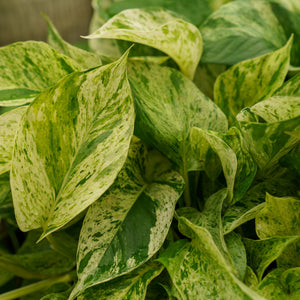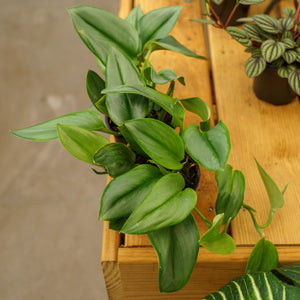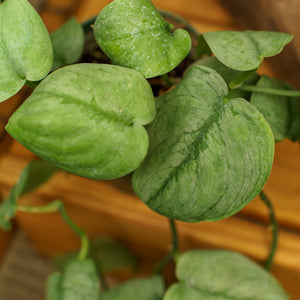The Pothos Guide
Pothos is one of the most popular and beginner-friendly houseplants, known for its vigorous growth, attractive foliage, and ability to thrive in a wide range of indoor conditions. Also called devil’s ivy, pothos is ideal for trailing, hanging, or climbing in both homes and offices. With stunning variegation, air-purifying qualities, and minimal maintenance needs, it's no wonder pothos remains a top pick for both novice and experienced plant lovers.
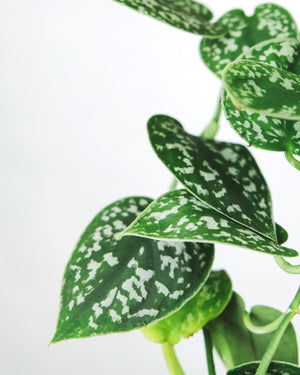
About
Pothos belongs to the Araceae family and is native to Southeast Asia and the Solomon Islands. It includes species in the Epipremnum and Scindapsus genera that are often grouped together due to their similar growing habits and care needs.
- Epipremnum aureum is the most common species, with heart-shaped leaves that trail or climb easily. Classic forms include 'Marble Queen' with creamy white marbling, 'Neon' with bright chartreuse leaves, and 'Pearls and Jade' with intricate variegation.
- Scindapsus pictus, often called satin pothos, features velvety, silver-spotted foliage. Varieties like 'Exotica' and 'Silver Hero' are known for their luxurious texture and muted tones.
- Scindapsus treubii 'Moonlight' is a rarer, silvery-toned climbing plant that offers a more upright form with dramatic leaves.
These adaptable plants tolerate low light, resist neglect, and grow happily in hanging baskets, on trellises, or across shelving.
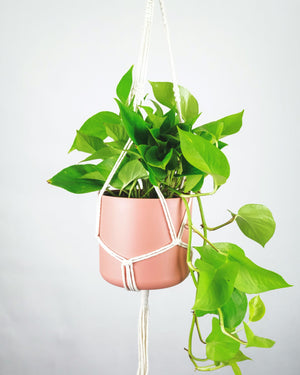
PLANTING
Planting pothos is straightforward and accessible for all skill levels:
- USDA Hardiness Zones: Typically grown indoors; hardy outdoors only in Zones 10–12.
- Soil: Use a light, well-draining potting mix. Add perlite or orchid bark to improve aeration.
- Light: Bright, indirect light is ideal. Variegated types like 'Marble Queen' need more light to maintain their patterns. Pothos tolerates low light but grows more slowly.
- Containers: Use pots with drainage holes. Hanging baskets, wall planters, or tabletop pots are all great choices.
- Planting Time: Pothos can be planted or repotted any time indoors. Spring is best for promoting faster root development.
Mount pothos on a moss pole or trellis to encourage climbing and larger leaf formation, especially for satin varieties.
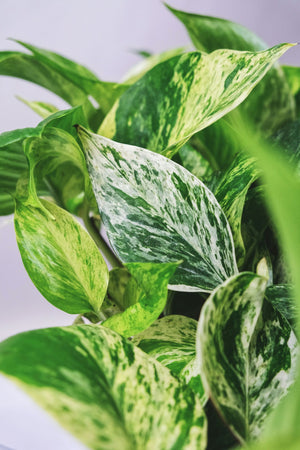
CARE
Once established, pothos requires minimal care and thrives with occasional attention:
- Watering: Water when the top 1–2 inches of soil feel dry. Avoid overwatering, which can lead to root rot. In lower light, reduce watering frequency.
- Humidity: Tolerant of average indoor humidity but appreciates added humidity in dry environments.
- Fertilizing: Feed monthly with a balanced liquid houseplant fertilizer during the growing season (spring through summer).
- Pruning: Trim stems to control length or encourage bushier growth. Remove yellow or damaged leaves regularly.
- Repotting: Repot every 1–2 years or when roots fill the pot. This is also a good time to propagate stem cuttings.
Yellowing leaves may signal overwatering, poor light, or a nutrient deficiency—adjust care accordingly.
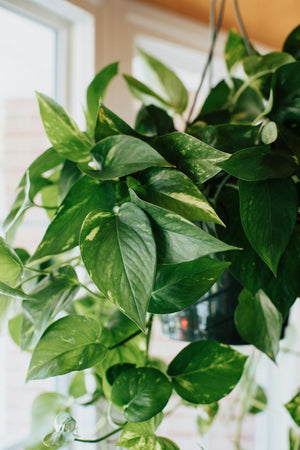
HOW TO USE
Pothos is extremely versatile and can be displayed in countless creative ways:
- Hanging Baskets: Let vines of 'Neon' or 'Pearls and Jade' cascade from planters to create a lush, dramatic look.
- Climbing Displays: Train pothos up a trellis, moss pole, or wall grid to add vertical greenery in small spaces.
- Bookshelves & Cabinets: Drape pothos along shelving or cabinets for a soft, trailing effect that adds organic balance to hard lines.
- Low-Light Corners: Place green-leafed pothos like standard Epipremnum aureum in lower-light rooms for reliable foliage.
- Plant Pairings: Combine with philodendron, ZZ plant, or snake plant for a bold, easy-care foliage collection.
Pothos plants are ideal for renters, students, and busy plant parents seeking beautiful greenery without complicated care routines.
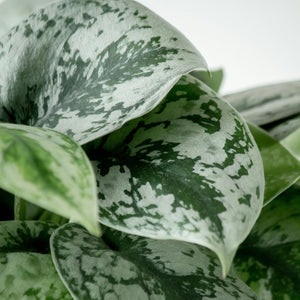
COMMON QUESTIONS
- How to propagate pothos? Take stem cuttings with 2–3 nodes, place them in water or moist soil, and roots will form in 2–4 weeks.
- Are pothos toxic to cats? Yes, pothos is toxic to cats if ingested and can cause irritation or vomiting.
- Are pothos toxic to dogs? Yes, pothos is also toxic to dogs if consumed.
- How often to water pothos? Every 7–10 days, depending on light, temperature, and humidity. Always let the top inch of soil dry out first.
- Why is my pothos turning yellow? Causes include overwatering, poor drainage, too much direct light, or lack of nutrients.
- How to care for pothos? Provide indirect light, let soil dry between waterings, prune as needed, and feed monthly during the growing season.
- How to prune pothos? Use clean scissors to cut just above a node. Pruning encourages fuller growth and is an opportunity to propagate new plants.
Conclusion
Pothos is the quintessential low-maintenance houseplant, valued for its lush foliage, forgiving nature, and flexible styling options. With dozens of cultivars and hybrids to explore, from the bright flair of 'Neon' to the refined shimmer of 'Silver Hero', pothos offers endless variety to indoor gardeners. Whether trailing, climbing, or cascading from shelves, it continues to earn its reputation as one of the best houseplants for beginners and experts alike.
The Pothos Collection
Sold Out
Sold Out
Sold Out
Sold Out
Sold Out

